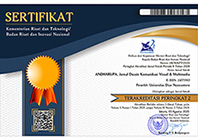Analysis of Photographer's Color Mood as a Japanese Brand Image Identity on Instagram Social Media
DOI:
https://doi.org/10.33633/andharupa.v9i4.9057Abstract
AbstrakManusia merupakan makhluk visual yang sebagian besar ingatannya berkaitan erat dengan apa yang dilihatnya. Ibarat seorang fotografer yang menggunakan kameranya untuk mengabadikan objek visual guna menyampaikan pesan visual melalui hasil tangkapan kameranya. Saat ini media sosial Instagram menjadi ruang pameran bagi sebagian besar fotografer untuk menunjukkan ciri khas dan keindahan objek yang diambilnya, termasuk ciri khas foto yang diambil oleh fotografer Jepang dapat menjadi identitas visual yang kuat. Penelitian ini dilakukan untuk melihat seberapa penting peran dari fotografer dalam kesamaan penggunaan color mood pada hasil foto yang diunggah di akun media sosial Instagram, adapun ciri khas ini dapat terlihat pada hasil foto dari fotografer Jepang. Penelitian akan menggunakan jenis penelitian kualitatif deskriptif dengan diperkuat survei terhadap pengguna media sosial Instagram yang kemudian dianalisa berdasarkan teori visual perception. Berdasarkan hasil dari penelitian ini menemukan bahwa kesamaan color mood pada hasil foto yang dipamerkan di media sosial Instagram fotografer Jepang dapat menjadi pemeran penting dalam sebuah brand image branding negara Jepang. Kata Kunci: brand image, city branding, fotografi, instagram, Jepang AbstractHumans are visual creatures whose memories are closely related to what they see. It's like a photographer who uses his camera to capture visual objects in order to convey visual messages through his camera's captures. Currently, Instagram social media has become an exhibition space for most photographers to show the characteristics and beauty of the objects they take, including the characteristics of photos taken by Japanese photographers that can become a strong visual identity. This research was conducted to see how important the role of photographers is in the similarity of the use of color mood in photos uploaded to Instagram social media accounts. This characteristic can be seen in photos from Japanese photographers. The research will use descriptive qualitative research, reinforced by a survey of Instagram social media users, which will then be analyzed based on visual perception theory. Based on the results of the research, it was found that the similarity of color mood in the photos exhibited by Japanese photographers on their Instagram social media can play an important role in the brand image of Japan's branding Keywords: brand image, city branding, Instagram, Japan, photographyReferences
Ahmad Faiz Muntazori, B. S. T. C., 2020. Dakwah Visual: Ekspresi Keimanan Seorang Muslim Dalam Bentuk Poster Digital. Human Narratives, 1(2), pp. 88-102.
Annisa Valentina, R. I., 2013. Gelombang Globalisasi ala Korea Selatan. Jurnal Pemikiran Sosiologi, 2(2), pp. 71-86.
Annur, C. M., 2023. Databoks. [Online] Available at: https://databoks.katadata.co.id/datapublish/2023/11/01/indonesia-masuk-5-besar-negara-dengan-pengguna-instagram-terbanyak-di-dunia#:~:text= Adapun%20jumlah%20pengguna%20Instagram%20di,pengguna%20Instagram%20pada%20Juli%202023. [Accessed 17 12 2023].
Barnard, M. (1998). Art, Design, and Visual Culture. Fifth Avenue, New York: St. Martin's Press.
Bavister, S. (2001). Lighting for Portrait Photography. Celigny, Switzerland: RotoVisioin SA.
Boy, S. M. (2014). Branding Tempat : Membangun Kota, Kabupaten, dan Provinsi Berbasis Identitas. Jakarta Selaetan: Makna Informasi.
Dameria, A. (2007). Color Basic : Panduan Dasar Warna untuk Desainer dan Industri Grafika. Jakarta: Link & Match Graphic.
Gobé, M. (2003). Emotional Branding. New York: Naggar Literary Agency.
Harsanto, P. W. (2016). Retorika Visual Fotografi Dalam Iklan Koran. Daerah Istimewa Yogyakarta: PT. Kanisius.
Hermawan Kartajaya, A. R. (2012). Branding with character. Jakarta: PT. Gramedia Pustaka Utama.
L.K. Peterson, C. D. (2000). Global Graphics: Color. United Stated of America : Rockport Publishers, Inc.
Missy Graham, E. J. A., 2013. Government Public Relations and Social Media: An Analysis of the Perceptions and Trends of Social Media Use at the Local Government Level. Public Relations Society of America , 7(4), pp. 1-21.
Nasrullah, R. (2019). Teori dan Riset Khalayak Media. Rawamangun, Jakarta: Prenadamedia Group.
Pujileksono, S. (2016). Metode Penelitian Komunikasi Kualitatif. Malang, Jawa TImur: Kelompok Intrans Publishing.
Robert Cumming, T. P. (1990). The Colour Eye. Wood Lande, London: BBC Books.
Rustan, S. (2019). Warna . Jakarta: PT. Lintas Kreasi Imaji.
Sebastian Zenker, E. B. (2010). The Place Brand Centre - A Conceptual Approach for the Brand Management of Places. 39th European Marketing Academy Conference, (pp. 1-8). Copenhagen, Denmark.
Shaked Gilboa, E. D. J. D. V. A. P. R. H., 2015. A summated rating scale for measuring city image. Cities, Volume 44, pp. 50-59.
Sume Ndumbe-Eyoh, A. M. (2016). Social Media, Knowledge translation, and action on the social determinants of health and health equity: A Survey of public health practices. Journal of Public Health Policy, 249-259.
Tillmanns, U. (1995). Kreatives Grossformat : Peoplefotografie. Schaffhausen, Switzerland: Verlag 'PHOTOGRAPHIE' AG.
Wesfix, T. (2017). Branding Itu "Dipraktekin". Palmerah Barat, Jakarta: PT. Grasindo.
Downloads
Published
Issue
Section
License
Authors who publish with this journal agree to the following terms:
- Authors retain copyright and grant the journal right of first publication with the work simultaneously licensed under a Creative Commons Attribution License that allows others to share the work with an acknowledgment of the work's authorship and initial publication in this journal.
- Authors are able to enter into separate, additional contractual arrangements for the non-exclusive distribution of the journal's published version of the work (e.g., post it to an institutional repository or publish it in a book), with an acknowledgment of its initial publication in this journal.
- Authors are permitted and encouraged to post their work online (e.g., in institutional repositories or on their website) prior to and during the submission process, as it can lead to productive exchanges, as well as earlier and greater citation of published work (See The Effect of Open Access).















